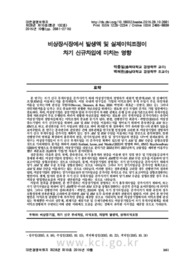

PARTNER
검증된 파트너 제휴사 자료
재량적 발생액과 부채조달비용 간의 관계에 대한 실증적 증거 (Empirical evidence on the relationship between discretionary accruals and cost of debt)
52 페이지
최초등록일 2025.06.06
최종저작일
2014.06

-
미리보기
서지정보
· 발행기관 : 한국회계학회
· 수록지 정보 : 회계학연구 / 39권 / 3호 / 359 ~ 410페이지
· 저자명 : 박종일, 윤소라
초록
본 논문의 목적은 재량적 발생액과 부채조달비용 간에 어떤 관계가 있는지를 규명하는데 있다. 선행연구들은 경영자가 기회주의적 이익조정 수단의 하나로 재량적 발생액(DA) 수준을 증가시키면 채권투자자들은 대출이자율을 증가시킬 것으로 예상하였다. 그러나 이러한 주장은 채권투자자들이 기업의 DA 수준에 대하여 효과적인 탐지가 가능할 것이라는 전제가 있어야 한다. 따라서 채권투자자 관점의 논의이다. 하지만 이와 상반되게 경영자 관점에서는 DA와 부채조달비용 간에 유의한 음(-)의 관계가 나타나야만 경영자는 부채조달비용을 낮추기 위한 동기로 DA를 이용할 경제적 유인이 발생될 수 있다. 본 연구는 부채차입이자율 스프레드로 측정된 부채조달비용(YS)과 DA 자체 변수 간에는 어떤 관계가 있는지를 살펴보는데 있어 이전 연구범위를 확장시켜 검증해 보았다. 본 연구에서는 두 변수 간의 관계에 대한 일반화 가능성을 제고하기 위하여 회사채를 발행한 기업뿐만 아니라 회사채를 발행하지 않은 기업에 대해서도 비교분석을 수행했다. 분석기간은 2001년부터 2011년까지이며, 표본은 금융업을 제외한 12월 결산법인으로 최종 10,479개 기업/연 자료가 분석에 이용되었다. 실증분석 결과에 따르면 첫째, 부A 자체와 YS 간에 1% 수준에서 유의한 음(-)의 관계가 있는 것으로 나타났다. 이 관계는 회사채를 발행한 기업들보다는 주로 회사채를 발행하지 않은 기업들에서 기인된 결과인 것으로 나타났다. 둘째, 선행연구와 달리 부채차입이자율 스프레드를 이용하여 분석하면 회사채를 발행한 기업의 경우 DA와 부채조달비용 간에는 대체로 유의한 관계가 나타나지 않았다. 셋째, Prevost et al.(2008)의 방법에 따라 DA와 비투자등급의 상호작용변수와 YS 간의 관계를 살펴본 결과, 채권투자자들이 DA를 직접 탐지하지 못할 뿐 아니라, 비투자등급의 정보위험이 DA를 대리하는 매개변수의 역할을 한다는 Prevost et al.(2008)의 주장은 관찰되지 않았다. 따라서 본 연구결과는 상장기업의 경영자들이 부채차입시에 부채조달비용을 낮추기 위한 동기로 DA를 이용하려는 경제적 유인이 존재한다는 것을 실증적 증거로서 보여주었다는데 의의가 있다. 이와 더불어 본 연구의 발견은 관련연구에 추가적인 공헌을 할 것으로 기대된다.영어초록
The purpose of this study is to examine the relationship between discretionary accruals and cost of debt financing. Earnings management studies are common in accounting literature. Theory and evidence indicate that managers’ concerns over current performance motivate them to engage in boosting reported earnings. Analysis of earnings management often focuses on management’s use of discretionary accruals. Managers can exercise discretion over accrual choices that are allowed under GAAP in order to reach a desired level of earnings. This is, firms’ management manages earnings because they have some incentives to do so. However, earnings management hides a true performance of a firm from debtholders and other external parties. Earnings management also distorts quality of reported earnings, and quality of accounting information impacts debtholders’ estimates of future cash flows from which debt repayments will be served. As a result, opportunistic earnings management activities increase information asymmetries between managers and outside investors with respect to a firm’s true underlying performance, which in turn increase information risk faced by outside investors. Especially, debtholders have contractually fixed claims such as periodic interest payments. They tend to focus on future cash flows to ensure a firm’s ability to pay interest and principal. In addition, unless debtholders can “see through” and undo earnings management, their resource allocation decisions are potentially affected in a negative way. In that regard, examining the effect of opportunistic earnings management in the debt market is important. Prior studies expected that debtholders increase interest rates on firm’s debts when managers increase discretionary accruals (DA) for the purpose of opportunistic earnings management. This expectation is coming from debtholders’ point of view, because it is based on the assumption that rational debtholders can effectively see through a firm’s level of discretionary accruals. Then, prior papers assert that rational debtholders are able to see through managers’ attempts to opportunistically influence earnings perceptions and penalize firms for doing so by demanding a higher rate of return. However, from manager’s point of view, we should observe the negative relationship between discretionary accruals and cost of debt, so we will be able to explain the managers’ economic motivation to decrease cost of debt using discretionary accruals.
Prior researches provide inconsistent empirical evidence on this relationship. Prevost et al. (2008) cannot find a significant relationship between discretionary accruals and cost of debt measured by bond’s yield spreads, while Park et al. (2011) and Lee and Ko (2012) find a significantly positive association between these two variables. However, these prior studies have several limitations. For example, Park et al. (2011) focus on bond issuing firms only and Lee and Ko (2012) measure discretionary accruals taking absolute value of them. Therefore, this study is meaningful because it extends prior researches and examines the association between cost of debt (YS) measured by borrowing’s yield spread and the level of discretionary accruals (DA). This paper analyzes all samples including not only bond issuing firms but also bond unissuing firms, and KOSPI and KOSDAQ listed firms in order to generalize the test results. Sample periods are from 2001 to 2011, and totally 10,479 firm-year samples are used in this research.
This paper finds the following results. First, there is a statistically significantly negative association between cost of debt and discretionary accruals at 1% level, even after controlling firms’ credit ratings and other variables that can affect firm’s cost of debt. This result is consistent in full samples including KOSPI and KOSDAQ firms, and in each type of stock markets separately. Also, we find the same results no matter whether we use discretionary accruals in Dechow et al. (1995) or performance-adjusted discretionary accruals in Kothari et al. (2005). Meanwhile, this significantly negative association between two variables is coming from bond unissuing firms rather than bond issuing firms. Second, unlike the prior studies, we cannot find a statistically significant relation between cost of debt and discretionary accruals in bond issuing samples when we measure cost of debt using borrowing’s yield spread. This is an inconsistent result with Park et al. (2011). Third, following Prevost et al. (2008), we examine the association between cost of debt financing and interaction term of discretionary accruals and non-investment grade rating (i.e., high default risk firms), but we cannot find that the yield penalty for earnings management is significantly greater for non-investment grade rating, and moreover, debtholders cannot see through the information risk of increasing level of discretionary accruals and managers’ attempts of opportunistic earnings management. As a result, we find inconsistent empirical test results with Park et al. (2011) and Lee and Ko (2012). Overall, these findings suggest that debtholders do not see through accruals- based earnings management. In other words, this evidence suggests that debtholders do not perceive earnings management as opportunistic behavior. Accounting information plays an important role in the capital allocation process. Accordingly, understanding the debt market consequences of earnings management is a relevant and an important issue.
In summary, this research implements various analyses to generalize the test result. We includes bond issuing firms and bond unissuing firms, and KOSPI and KOSDAQ firms. We use bare value of discretionary accruals, not just degree of DA, and performance-adjusted DA. We also use a different measurement of cost of debt financing, which is borrowing’s yield spread. With these various approaches, we find that discretionary accruals are statistically significantly negatively associated with cost of debt financing. Therefore, it can support the fact that managers do have economic motivation of opportunistic attempt of earnings management using discretionary accruals in order to reduce cost of debt. This implies that debtholders cannot effectively detect increasing information risk of firms due to the earnings management and they do make a capital allocation decision functionally fixed to reported earnings, although managers increase reported earnings using discretionary accruals in order to reduce cost of debt. Therefore, this study provides several meaningful contributions because it can be an evidence of inefficient allocation of resources in the debt market due to managers’ opportunistic attempts of earnings management.
This research also contributes to provide useful information regarding earnings management to scholars, practitioners, accounting standard setters, and regulators alike. In addition, researchers who are interested in this area can also apply the discussion in this paper for future studies.참고자료
· 없음태그
-
자주묻는질문의 답변을 확인해 주세요

꼭 알아주세요
-
자료의 정보 및 내용의 진실성에 대하여 해피캠퍼스는 보증하지 않으며, 해당 정보 및 게시물 저작권과 기타 법적 책임은 자료 등록자에게 있습니다.
자료 및 게시물 내용의 불법적 이용, 무단 전재∙배포는 금지되어 있습니다.
저작권침해, 명예훼손 등 분쟁 요소 발견 시 고객센터의 저작권침해 신고센터를 이용해 주시기 바랍니다. -
해피캠퍼스는 구매자와 판매자 모두가 만족하는 서비스가 되도록 노력하고 있으며, 아래의 4가지 자료환불 조건을 꼭 확인해주시기 바랍니다.
파일오류 중복자료 저작권 없음 설명과 실제 내용 불일치 파일의 다운로드가 제대로 되지 않거나 파일형식에 맞는 프로그램으로 정상 작동하지 않는 경우 다른 자료와 70% 이상 내용이 일치하는 경우 (중복임을 확인할 수 있는 근거 필요함) 인터넷의 다른 사이트, 연구기관, 학교, 서적 등의 자료를 도용한 경우 자료의 설명과 실제 자료의 내용이 일치하지 않는 경우
“회계학연구”의 다른 논문도 확인해 보세요!
-
재무적 여력이 판매관리비의 하방경직성에 미치는 영향 41 페이지
본 연구에서는 기업의 재무적 여력(financial slack)이 판매관리비 행태에 미치는 영향을 분석하였다. 재무적 여력은 고정비용으로 인한 재무적 위험을 낮추어 매출감소시에도 수익성 높은 기업자원을 유보하는 경향을 강화할 것이므로 이에 따라 판매관리비의 하방경직성이 강화될 것이다. 또한, 영업현금흐름의 변동성이 큰 기업은 투자재원의 제약으로 인해 자원을.. -
회계이익과 과세소득의 차이가 회사채 신용등급에 미치는 효과에 대한 재검토 및 새로운 증거 55 페이지
본 연구는 회계이익과 과세소득의 차이(BTD)가 회사채 신용등급(RATING)에 미치는 영향을 분석하였다. 본 연구는 이전 연구들의 주장과 같이 경영자의 기회주의적 이익조정으로 보고이익이 상향조정되면 회계이익이 과세소득보다 커질 수 있어 이익의 질은 낮아질 것으로 보고, 이런 경우 신용평가기관이 신용등급을 더 낮출 것으로 기대했다. 실증분석기간은 2001년.. -
대규모기업집단 소속기업의 투자효율성 44 페이지
본 연구에서는 대규모기업집단 소속기업들의 투자효율성에 대해 분석하였다. 과거의 국내외 연구들은 대규모기업집단 소속기업들이 비효율적이고 많은 문제점을 가지고 있다고 보고한 경우가 많았다. 그러나 최근 수행된 다수의 연구들은 오히려 대규모기업집단 소속기업들이 기타 기업들에 비해 우수하다는 증거들을 다수 제시하고 있다. 본 연구에서 대규모기업집단 소속기업들을 기.. -
산업 내 경쟁정도와 실제이익조정 - 기업지배구조와의 상호작용을 중심으로 - 34 페이지
본 연구는 상품시장 차원에서의 경쟁 정도 및 기업의 시장지배력이 경영자의 회계선택의 일환으로 여겨지는 실제 이익조정(real earnings management) 행태에 어떤 영향을 미치는지를 규명하고자 다양한 측면에서 실증분석을 수행하였다. 분석 결과를 요약하면 다음과 같다. 첫째, 독점도가 높은 산업에 속한(산업 내 경쟁정도가 낮은 산업에 속한) 기업일.. -
파트너연고 감사인변경과 회계정보 가치관련성의 관계 43 페이지
선행연구(Blouin et al. 2007; Vermeer et al. 2008 등)에서는 감사담당 파트너의 소속 회계법인(감사인) 이동을 따른 고객회사의 감사인변경을 “파트너연고 감사인변경(auditor changes following partner familiarity)”이라고 표현하였다. 국제적 대형회계법인의 급격한 변동이 있었던 2000년대 초, 국..
찾으시던 자료가 아닌가요?
지금 보는 자료와 연관되어 있어요!
문서 초안을 생성해주는 EasyAI


